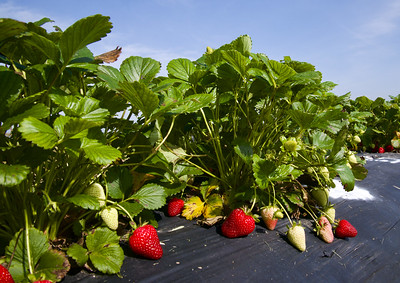YEAREND: Arkansas berries had an early start in 2024, but challenges await in 2025
Dec. 16, 2024
By Sarah Cato
U of A System Division of Agriculture
Fast facts
- Arkansas berries had a good season in 2024
- Warm February led to earlier than usual harvest for berry crops
- Disease, planting issues threaten 2025 strawberry crop
(673 words)
(NEWSROOMS: download photos of strawberries, blackberries, McWhirt and Cato.)
LITTLE ROCK – A warmer-than-usual spring led to an early harvest in 2024 for Arkansas berries, while an emerging disease and issues with planting leave a lot up in the air for strawberries in 2025.

Although blackberries, blueberries and strawberries were early in 2024, the warm, dry spring provided good growing conditions, said Amanda McWhirt, extension horticulture production specialist for the University of Arkansas System Division of Agriculture.
“There were several crops that were anywhere from two to three weeks early,” McWhirt said. “That really helped our strawberry growers initially because it really got them going. There was some concerns consumers wouldn’t be ready for strawberries that early. But we had a fairly good strawberry season.”
Although strawberry growers fared well overall in 2024, they still faced pest issues.
“The early warm weather we saw in February resulted in heavy plant bug pressure in strawberries statewide,” said Aaron Cato, extension horticulture integrated pest management specialist for the Division of Agriculture. “In April, we saw infestations and damage in every field we visited.”
However, McWhirt said many growers agreed that 2024 was an average year for berry crops, aside from heavy rain in the late season and an unusual break between blackberry and muscadine production.
“Usually our blackberry harvest butts up to our muscadine season,” McWhirt said. “But since our blackberries were so early this year, a lot of our growers had a good little break between the two seasons.”
Unknowns await in 2025
2025 may prove even more abnormal for Arkansas strawberry growers with a new disease threatening their crop.
“Neopestalotiopsis, aka. Pestalotia fruit rot and leaf spot, caused by the Neopestalotiopsis pathogens, is an emerging disease that made headlines in 2019 and 2020 when it was first reported to severely impact strawberry production in Florida,” Cato said. “Many growers are on edge going into the 2025 season as some strawberry plant suppliers and nurseries across the Southeast are warning of issues with Neopestalotiopsos in tip production fields, where our growers source their plants.”
Neo-P, as it is commonly called, is caused by a pathogen that is new and not very well understood. This aggressive pathogen attacks the leaves and fruit of strawberry and can lead to complete collapse even before fruit is produced. Cato recommends an integrated approach to management with several forms of cultural control as well as a strict fungicide spray schedule with effective products for growers to manage Neo-P in their fields.
“The good thing is that experience in other states suggests that there are several pest management tactics that can help suppress Neo-P,” Cato said. “With that being said this disease is still not well understood. For those growing strawberries this year, pest management programs need to remain vigilant and growers need to be augmenting strategies based on what the environment gives us and what they see in the field.”
Cato’s recommendations on Neo-P control can be found in his blog post.
Fewer strawberries in 2025?
McWhirt stressed that while Neo-P can impact strawberry yields, there are no concerns with food safety. However, the yield-limiting potential of Neo-P, paired with dry conditions this fall has caused some growers to opt out of strawberry production all together for 2025.
“We had another dry, hot summer. It was so continually dry, especially in Northwest Arkansas, that some people had trouble laying their beds to plant strawberries in the fall because the soil was just too dry,” McWhirt said. “So a lot of people that missed timings either planted late or just chose not to plant strawberries this year. We will likely have lower acreage going into 2025.”
Those interested can stay up to date on current issues in specialty crops and research-based recommendations through McWhirt and Cato’s Fruit, Vegetable and Nut Update and by following their Facebook page.
To learn more about Division of Agriculture research, visit the Arkansas Agricultural Experiment Station website: https://aaes.uada.edu. Follow on Twitter at @ArkAgResearch. To learn more about the Division of Agriculture, visit https://uada.edu/. Follow us on Twitter at @AgInArk. To learn about extension programs in Arkansas, contact your local Cooperative Extension Service agent or visit www.uaex.uada.edu.
About the Division of Agriculture
The University of Arkansas System Division of Agriculture’s mission is to strengthen agriculture, communities, and families by connecting trusted research to the adoption of best practices. Through the Agricultural Experiment Station and the Cooperative Extension Service, the Division of Agriculture conducts research and extension work within the nation’s historic land grant education system.
The Division of Agriculture is one of 20 entities within the University of Arkansas System. It has offices in all 75 counties in Arkansas and faculty on five system campuses.
Pursuant to 7 CFR § 15.3, the University of Arkansas System Division of Agriculture offers all its Extension and Research programs and services (including employment) without regard to race, color, sex, national origin, religion, age, disability, marital or veteran status, genetic information, sexual preference, pregnancy or any other legally protected status, and is an equal opportunity institution.
# # #
Media Contact: Sarah Cato
U of A System Division of Agriculture
Cooperative Extension Service
870-815-9035